If you want to know about the water supply requirements for building or water supply system in tall building or sustainable building design, please click the link.
A water distribution system at the city level typically consists of a complex network of pipes, pumps, reservoirs, and treatment plants designed to deliver clean and safe water to homes, businesses, and public facilities throughout the urban area. The primary goals of such a system are to ensure a reliable supply of water, maintain adequate pressure in the pipes, and prevent contamination of the water supply.
- The purpose of distribution system is to deliver water to consumer with appropriate quality, quantity and pressure.
- Distribution system is used to describe collectively the facilities used to supply water from its source to the point of usage.
1) Requirements of good distribution system
- Water quality should not get deteriorated in the distribution pipes.
- It should be capable of supplying water at all the intended places with sufficient pressure head.
- It should be capable of supplying the requisite amount of water during fire fighting.
- The layout should be such that no consumer would be without water supply, during the repair of any section of the system.
- It should be fairly water-tight as to keep losses due to leakage to the minimum.
- All the distribution pipes should be preferably laid one metre away or above the sewer lines.
2) Layouts of Distribution Network
- Dead End System
- Radial System
- Grid Iron System
- Ring System
i) Dead End System
- It is suitable for old towns and cities having no definite pattern of roads.

Advantages
- Relatively cheap.
- Determination of discharges and pressure easier due to less number of valves.
Disadvantages
- Due to many dead ends, stagnation of water occurs in pipes.
ii) Radial System
- The area is divided into different zones.
- The water is pumped into the distribution reservoir kept in the middle of each zone.
- The supply pipes are laid radially ending towards the periphery.
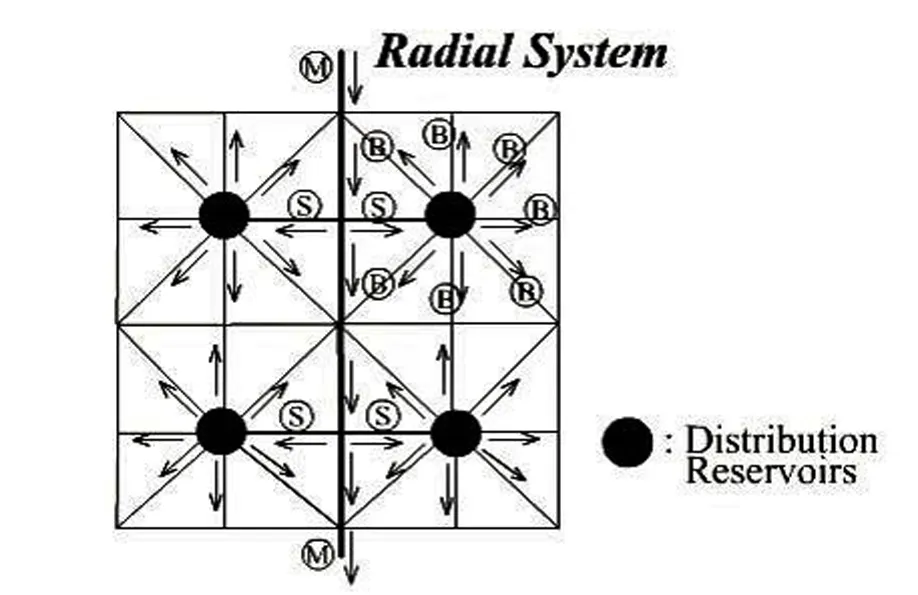
Advantages
- It gives quick service.
- Calculation of pipe sizes is easy.
iii) Grid Iron System
- It is suitable for cities with rectangular layout, where the water mains and branches are laid in rectangles.
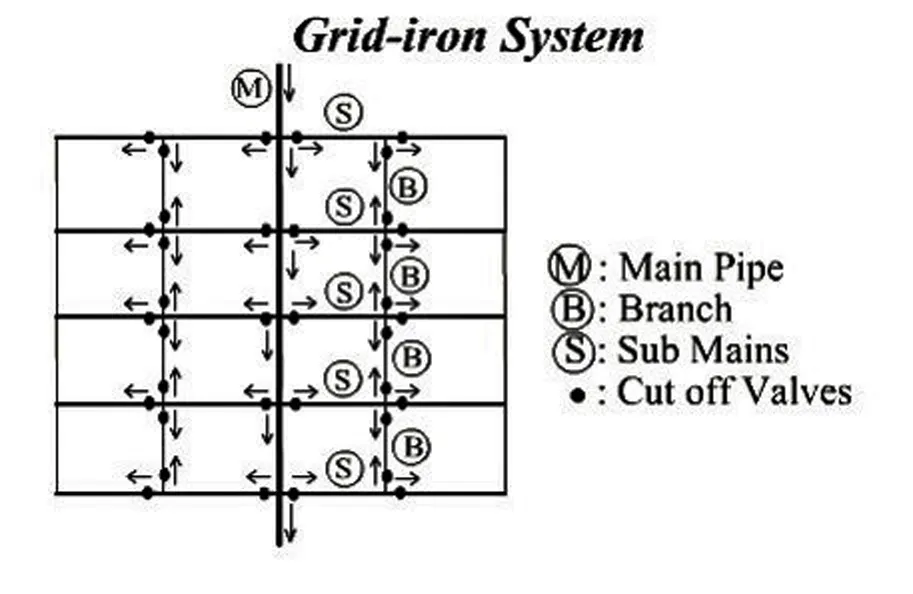
Advantages
- Water is kept in good circulation due to the absence of dead ends.
- In the cases of a breakdown in some section, water is available from some other direction.
Disadvantages
- Water is kept in good circulation due to the absence of dead ends.
- In the cases of a breakdown in some section, water is available from some other direction.
iv) Ring System
- The supply main is laid all along the peripheral roads and sub mains branch out from the mains.
- This system also follows the grid iron system with the flow pattern similar in character to that of dead end system.
- So, determination of the size of pipes is easy.
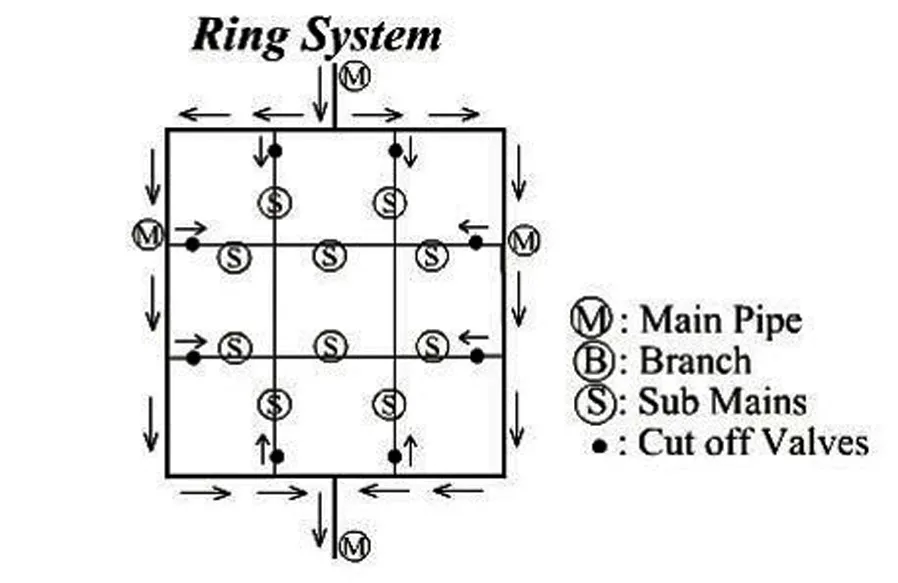
Advantages
- Water can be supplied to any point from at least two directions.
3) Methods of water distribution
- For efficient distribution system adequate water pressure required at various points.
- Depending upon the level of source, topography of the area and other local conditions the water may be forced into distribution system by following ways –
- Gravity system
- Pumping system
- Combined gravity and pumping system
i) Gravity system
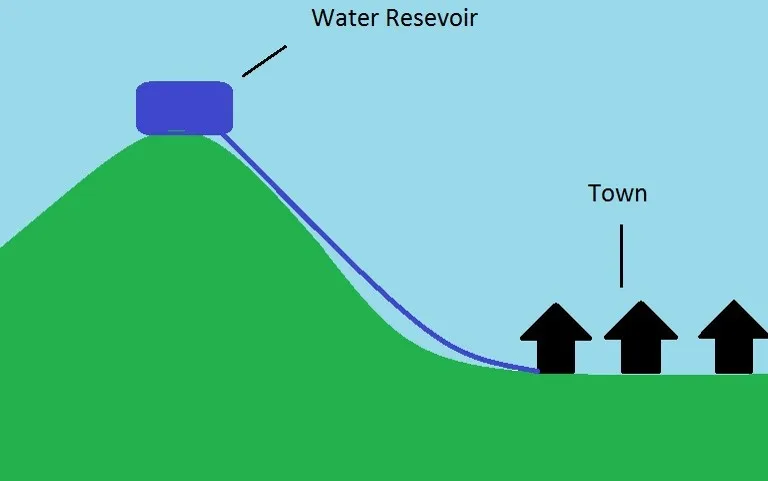
- Suitable when source of supply is at sufficient height.
- Most reliable and economical distribution system.
- The water head available at the consumer is just minimum required.
- The remaining head is consumed in the frictional and other losses.
ii) Pumping system

- Treated water is directly pumped in to the distribution main with out storing.
- Also called pumping without storage system.
- High lifts pumps are required.
- If power supply fails, complete stoppage of water supply.
- This method is not generally used.

iii) Combined gravity and pumping system

- Most common system.
- Treated water is pumped and stored in an elevated distribution reservoir.
- Then supplies to consumer by action of gravity.
- The excess water during low demand periods get stored in reservoir and get supplied during high demand period.
- Economical, efficient and reliable system.
5) Distribution Reservoirs
- Distribution reservoirs, also called service reservoirs, are the storage reservoirs, which store the treated water for supplying water during emergencies (such as during fires, repairs, etc.) and also to help in absorbing the hourly fluctuations in the normal water demand.
i) Functions of Distribution Reservoirs
- to absorb the hourly variations in demand.
- to maintain constant pressure in the distribution mains.
- water stored can be supplied during emergencies.
ii) Location and Height of Distribution Reservoirs
- should be located as close as possible to the centre of demand.
- water level in the reservoir must be at a sufficient elevation to permit gravity flow at an adequate pressure.

6) Types of Reservoirs
Depending upon their elevation w.r.t ground it may be classified into
- Surface reservoirs
- Elevated reservoirs
i) Surface reservoirs
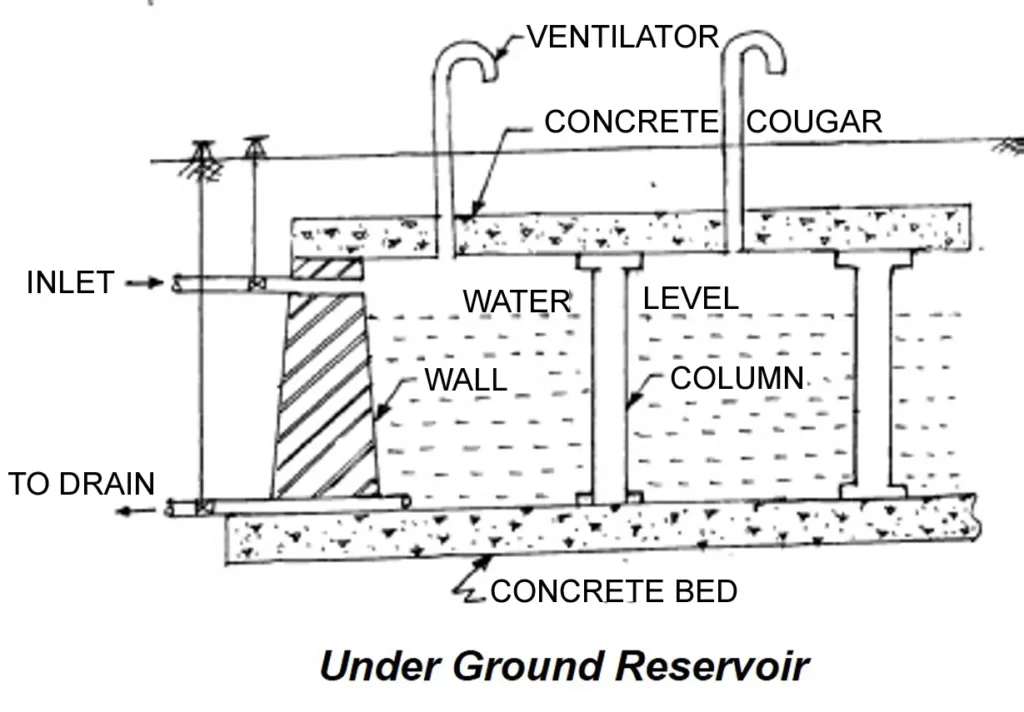
- These also called ground reservoir.
- Mostly circular or rectangular tank.
- Under ground reservoirs are preferred especially when the size is large.
- These reservoirs are constructed on high natural grounds and are usually made of stones, bricks, plain or reinforced cement concrete.
- The side walls are designed to take up the pressure of the water, when the reservoir is full and the earth pressure when it is empty.
- The position of ground water table is also considered while designing these reservoirs.
- The floors of these reservoirs may constructed with R.C.C slab or square stone blocks resting on columns.
- To obtain water tightness bitumen compounds are used at all construction joints.
- At the top of roof about 60cm thick earth layer is deposited and maintained green lawns to protect the reservoir from cold and heat.
- For aeration of water and inspection, ventilation pipes and stairs are provided.
Types of tanks
- R.C.C Tanks: R.C.C tanks are very popular because
- They have long life
- Very little maintenance
- decent appearance
- G.I. Tanks: G.I. tanks are generally in rectangular or square in shape. Now a days G.I. tanks are not preferring because
- Life of the tank is short
- Corrosion of metal
- maintenance cost may be more
- HDPE Tanks: Now a days HDPE tanks are very popular for storing less quantity of water and hence useful for residential purpose. The following are the advantages of HDPE tanks
- Handling is easy because of light weight
- Cheap in cost
- Maintenance cost is low
- Cleaning of tanks are easy
ii) Elevated reservoirs
- Elevated Storage Reservoirs (ESRs) also referred to as Overhead Tanks are required at distribution areas which are not governed and controlled by the gravity system of distribution.
- These are rectangular, circular or elliptical in shape.
- If the topography of the town not suitable for under gravity, the elevated tank or reservoir are used.
- They are constructed where combine gravity and pumping system of water distribution is adopted.
- These tanks may be steel or RCC.
- Now RCC is commonly preferred.
The accessories of ESR are-
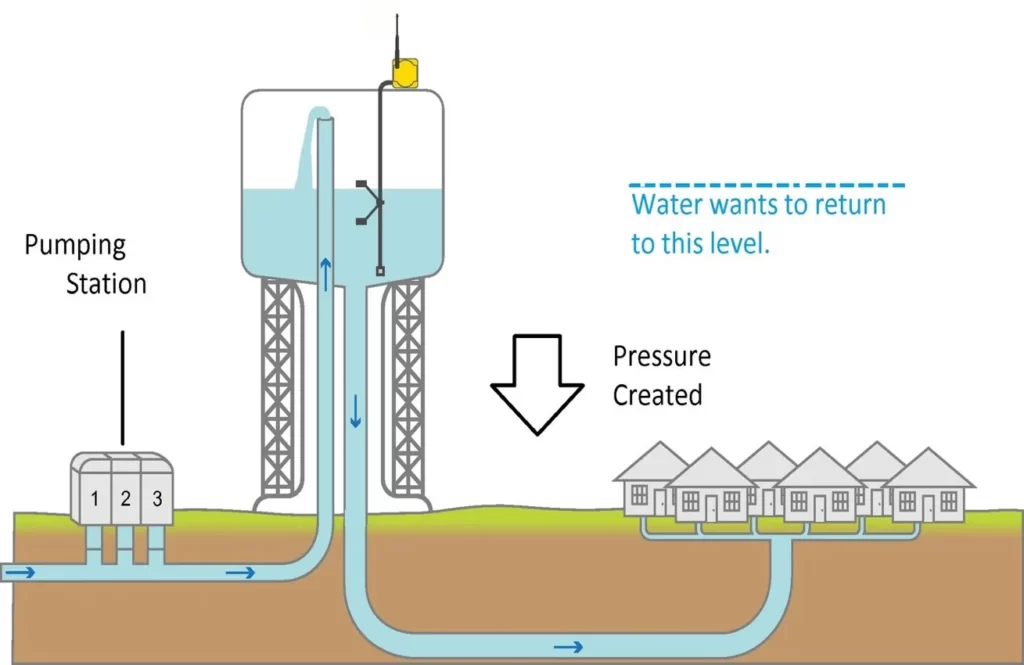
- Inlet and outlet pipe, overflow pipe discharging into a drain
- Float gauge, indicating depth of water.
- Automatic device to stop pumping when the tank is full.
- A manhole and ladder.
- Ventilator for circulation of fresh air.
Overall, the water distribution system at the city level is a critical infrastructure that plays a vital role in maintaining public health and safety, as well as supporting economic growth and development. It requires careful planning, design, and management to ensure that it is able to meet the needs of the community now and in the future.